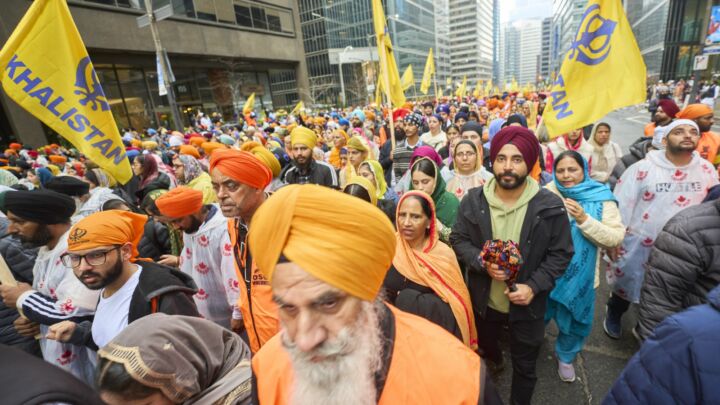An Olympic-sized bubble in east London
The 2012 ‘makeover’ of east London is just a rehash of the finance-driven economic mistakes of the past.

Want to read spiked ad-free? Become a spiked supporter.
I, like many other British people I suspect, felt relief when rowers Helen Glover and Heather Stanning and cyclist Bradley Wiggins won Britain’s first Olympic gold medals in the middle of the first week of the Games. Perhaps, at last, the sport could take centre stage after weeks in which politicians and media commentators have generated fears about security and transport: panics of the former’s making and fanned by the latter. The opening ceremony – more comfortable with presenting a mythologised past than anticipating with any confidence the nation’s future – did little to calm nerves. The absence of gold in the first few days only served to strengthen the prevailing message from the host city that it isn’t the Games that really matter, but another (mythical) narrative: their legacy.
UK prime minister David Cameron focused several speeches on legacy in the run up to the Games. A day or two before the Games began, at a meeting with International Olympic Committee (IOC) president Jacques Rogge, Cameron seized upon a timely report from London 2012 sponsors Lloyds TSB. The bank’s report estimated public investment in London 2012 would obtain a £16.5 billion boost to the UK economy by 2017 as proof of the event’s positive economic effects on UK plc.
Rogge, in turn, supported his host’s view: ‘London has raised the bar on how to deliver a lasting legacy. We can already see tangible results in the remarkable regeneration of east London. This great historical city has created a legacy blueprint for future Games hosts.’ But what really has the £9.3 billion public investment achieved? What real longer-term economic and social benefits for London and the UK might arise from harnessing the hosting of the Games to a programme of urban renewal?
It’s important to remember that government spending – capital or current – does not solve the problems of a stagnant economy. The underlying problem for capital at such times isn’t the lack of consumer demand, but the inadequacy of profits available to invest in business expansion and development. The best that state intervention may achieve is the supply of credit to financial institutions and other businesses (thus averting bankruptcies); the provision of welfare to alleviate social distress; and the creation of infrastructure to support future economic activity which the authorities hope will be profitable. In Britain today, the government is doing the first with the help of the Bank of England through quantitative easing and other measures, in effect buying the economy some time. Secondly, it is providing welfare benefits, but simultaneously reducing the scope and value of these benefits; these cuts often affect the most vulnerable. Lastly, the government is modestly investing in infrastructure, the direct and indirect investment in east London being a key example.
The Games provide a useful legitimation for a government policy that invests public money in contracts for private enterprise to build the Olympic Park and improve London’s ailing transport infrastructure. The hope is that such activity might secure future private capital-investment and kickstart economic growth, at least in the city and its eastern fringe. To this end, the Games provide a showcase for the city, an opportunity for London mayor Boris Johnson to ‘shamelessly promote London as the leading business hub in Europe’. Alongside these aspirations, successive governments since 2005 have pledged to transform east London, achieving longer-term benefits for existing, socially disadvantaged communities – pockets of which are among the poorest in England. Such diverse aspirations carry an air of unreality and, in practice, are irreconcilable, as a brief look at housing, employment and inward investment reveals.
Housing
It is estimated that about 8,000 new homes will be created by the zonal development of the Olympic Park, post-2012. In the pre-event phase, about 450 social-housing units were demolished to make way for the park’s development. Initial plans for the Olympic Park were for 4,000 homes and this was revised downwards to 2,800. It was argued that this was the result of concerns about the density of the scheme. In 2009, a funding package was agreed through a mix of grants and loans, and the creation of Triathlon Homes (a consortium of two housing associations and a design company) to purchase around half (1,379) of these homes. The proportion of housing provided through Triathlon will be designated ‘affordable’ housing, with around half of these for social rent and the other half for sale through a range of ‘affordable’ housing options.
Qatar Holdings (a sovereign-wealth fund) and Delancey (an international property-services company) signed a £557million contract to purchase and manage the Olympic Village. They will own 1,439 properties. Current plans are to rent these properties, which will form part of the first UK private residential investment fund. Qatar Holdings and Delancey have also purchased six adjacent development slots, with the capacity to provide 2,000 homes.
While this deal enabled the government to recoup some of the costs of the Olympic Village development, the agreement has resulted in a considerable loss to the public purse, and it is not clear how it will fit with plans for creating an ‘inclusive’ neighbourhood. The pressure to create a desirable environment attractive to those willing to pay substantial rents is likely to shape the tenancy of the ‘affordable’ housing. Already, there are local-authority interventions to ensure that more ‘desirable’ groups, such as ‘key workers’, have access to the housing over those unemployed and dependent upon benefits.
Developments on the borders of the Olympic Park are following a similar trajectory. Stratford High Street and plans for parts of the Lower Lea Valley, involving, among others, companies such as Ikea, are committed to the construction of islands of gentrification, designed largely for ‘buy-to-let’ purposes aimed at young professionals and overseas investors, rather than local, typically poorer communities.
Employment
The gateway to the Olympic Park is Westfield Stratford City, a £1.45 billion private investment. It is a shopping mall with 300 shops (many of them designer outfits), 70 restaurants, a multiplex cinema and London’s largest casino. It was opened in September 2011. Conceived at the peak of the city’s phase of consumption-oriented, service-led development, the mall attracted thousands of shoppers on its opening weekend and has created approximately 8,500 jobs (2,000 of which have been filled by local people). Westfield Stratford is the second major shopping mall opened in London by Westfield, an Australian retail-development company and one of London 2012’s Olympic sponsors.
While the shopping mall provides much needed jobs in the area (employing about 200 long-term jobless people), it is reproducing a familiar pattern of employment in the UK’s capital. Employment in London divides between high-income and skilled jobs on the one hand and low-income, flexible forms of employment on the other. The retail sector reinforces this trend, providing, in particular, the latter forms of labour. The vast shopping mall is providing jobs in the area, but is also likely to reproduce existing patterns of work inequality, reinforcing the polarised nature of the city’s labour market.
Inward investment
Olympic-period inward investment in London has been largely focused upon two main aspects: the city’s high-end property market, and projects aimed at using London to showcase the research and productive activities that international enterprises undertake elsewhere in the world. The former is illustrated by the engagement of international investors with the Olympic Village (1) and the latter by Siemens’ construction of an exhibition and conference centre in London’s Docklands, a centre that aims to advertise green technologies to the world.
In this sense, the future economic trajectory proposed for east London mirrors that of the city over the recent past: services-led and consumption-driven. Hosting the Olympics has, at best, merely confirmed that the east side of the city may provide new urban spaces for the promotion of ‘creative’ brands that sit adjacent to Canary Wharf. This is simply affirming the city’s role as the great ‘go-between’ whose future rests upon its role in sustaining the circuitous routes of capital whose accumulation takes place elsewhere.
In summary, the tensions arising from harnessing the Games to the redevelopment of east London are clearly emerging. While the Legacy Corporation proposes to achieve a balance between social and commercial development, with a publicly stated concern to secure some real benefits for local communities, it is working to tightly defined financial constraints and within the framework of current government social policy, especially in relation to the provision of housing and welfare benefits. On the Olympic Park’s borders, an even less-nuanced imagination of urban development is emerging, an urban landscape that is likely to achieve a form of regeneration that reinforces rather than reduces the long-established patterns of social inequality in London’s East End.
A combination of continued recessionary trends in the wider economy, the incapacity of policymakers to redesign the Olympic urban-development programme to move away from the consumption-led/speculative property-development model, and the continued implementation of central-government social policies over the next two years is generating pressures that are propelling London’s Olympic legacy toward a form of city-building that emulates what sociologists have described as ‘splintered urbanism’.
In short, London 2012’s blueprint for future Olympic cities amounts to a rehash of its bubble-laden past.
Gavin Poynter is professor in social sciences, University of East London. His latest publication is a co-edited book (with Professor Iain MacRury and Dr Andrew Calcutt) ‘London After Recession – a fictitious capital’. The book will be published this month (August 2012) by Ashgate Press. Previously he edited, with Iain MacRury, ‘Olympic Cities’, Ashgate 2009.
Celebrate 25 years of spiked!
A media ecosystem dominated by a handful of billionaire owners, bad actors spreading disinformation online and the rich and powerful trying to stop us publishing stories. But we have you on our side. help to fund our journalism and those who choose All-access digital enjoy exclusive extras:
- Unlimited articles in our app and ad-free reading on all devices
- Exclusive newsletter and far fewer asks for support
- Full access to the Guardian Feast app
If you can, please support us on a monthly basis and make a big impact in support of open, independent journalism. Thank you.






Comments
Want to join the conversation?
Only spiked supporters and patrons, who donate regularly to us, can comment on our articles.